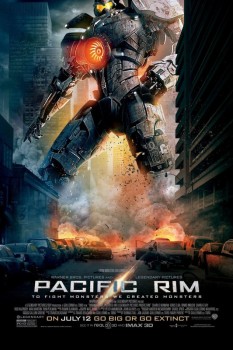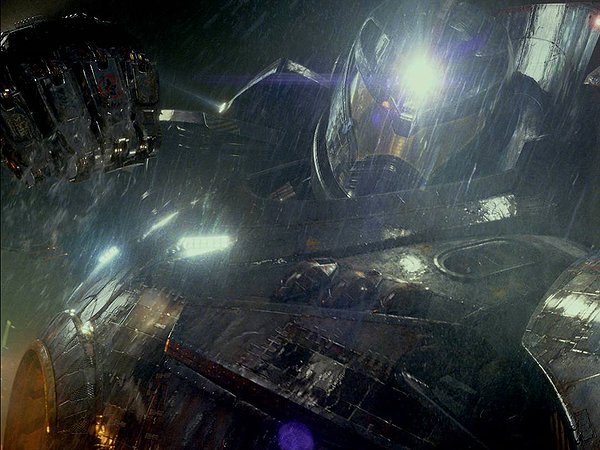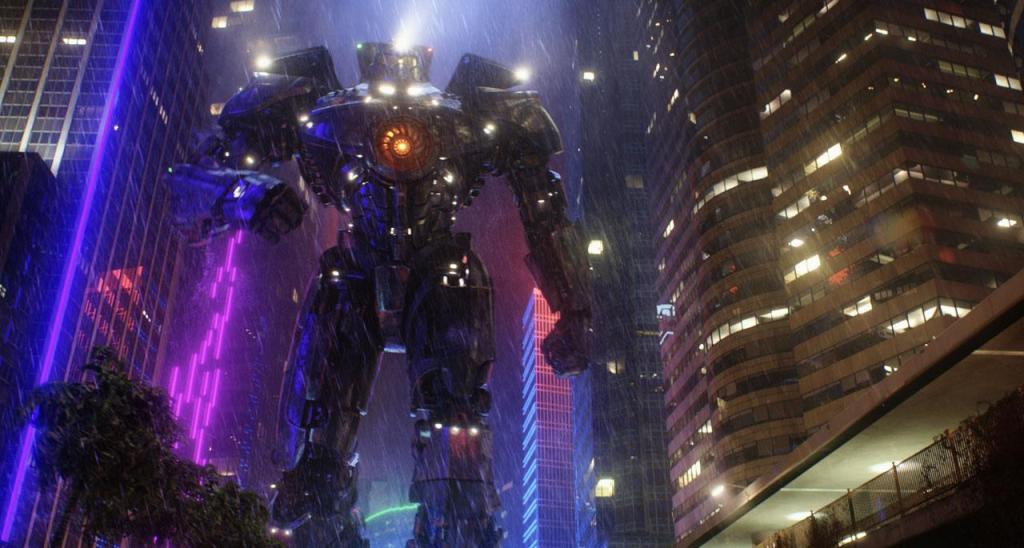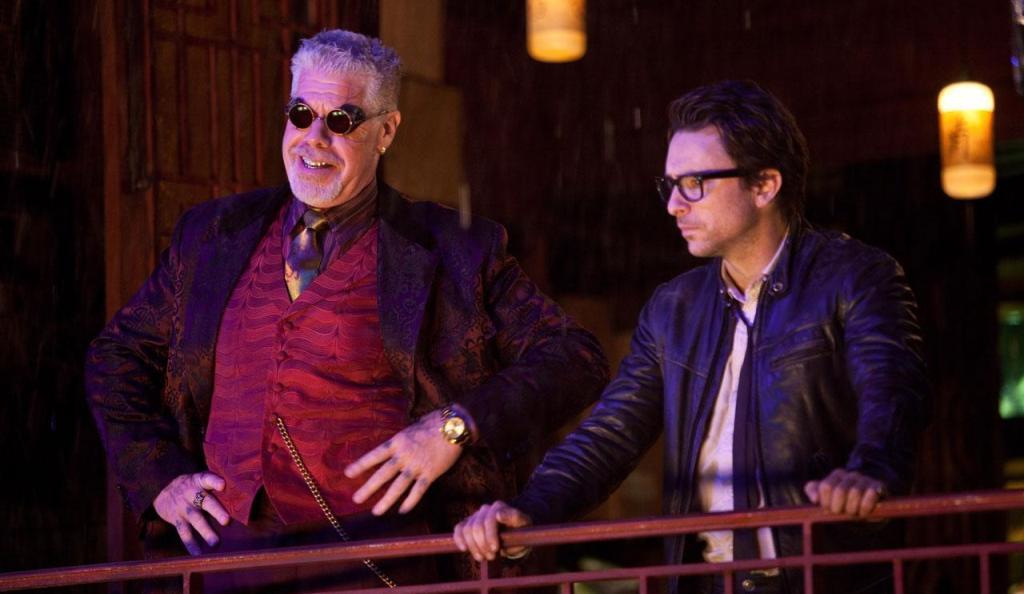Pacific Rim Loves You. Love It Back.
 Pacific Rim (2013)
Pacific Rim (2013)
Directed by Guillermo del Toro. Starring Charlie Hunnam, Idris Elba, Rinko Kikuchi, Charlie Day, Rob Kazinsky, Max Martini, Ron Perlman.
If you choose to see Grown Ups 2 this week instead of Pacific Rim, I will come after you. I know nothing about engineering, but I will find a way to build a titanic super robot and hunt you down. I know nothing about genetics, but I will find a way to grow a mutated giant monster and put it on your trail. And if you spent any money on any of the Transformers movies and you don’t go see Pacific Rim….
R-A-G-E!
Pacific Rim is here for you, summer movie fans and science-fiction worshippers: an original, thrilling, no-bloat SF geek explosion. Every summer has that film, the one that reminds us what fun the warm season movies are supposed to be, and makes us leave the theater walking tall as a 50-meter robot and loving life like a thirteen-year-old kid who hit the bank with a lemonade stand and can now afford that new video game.
I’ll admit a strong bias here, which is the same one that director Guillermo del Toro has: a reverence for the cinematic marvel of watching giant monsters knocking crap over. Pacific Rim is a contemporary love poem to Toho Studios and Tsubaraya Productions in the 1960s, the folks who brought the eruption of outrageous fun kaiju cinema. (Kaiju as Pacific Rim’s title cards define it means “giant monster.” I’ll be nitpicky as a fan and point out that the literal Japanese meaning is “strange beast,” with no reference to size. Daikaiju means “giant strange beast.” However, in fan speak kaiju has come to refer to the entire genre of special effects films centered on giant creatures.) Del Toro creates a whole world where giant monsters and human-piloted robotic suits can slug away at each other in awe-inspiring set-pieces stuffed with hero poses and fist-pumping victory shots. It’s so damn gorgeous and it feels so good.
The background story of Pacific Rim is laid out during the fifteen-minute pre-title card sequence, which thankfully eliminated the need to make this an “origin story” that takes forever to get to the main event. Narration from our hero, Raleigh Becket (Charlie Hunnaman), explains that a dimensional rift in the floor of the Pacific has spit out waves of Kaiju to attack cities on the ocean’s edge. San Francisco receives the initial strike. Our first image of a Kaiju is a beauty, with the creature smashing apart the Golden Gate Bridge to remind us that famous landmarks exist so that big monsters can wreck ‘em. (See It Came from Beneath the Sea for a Golden Gate-specific example from the classic era.)
The monster onslaught leads the nations of Earth to fight back in a united front. But how can humanity fight big monsters? There’s only one answer: build big robot suits! These “Jaegers” use teams of two pilots with neural links to guide them into confrontations with the huge beasties. The pilots need a special link, “drift compatibility,” to most effectively work together — but this link carries the danger of potential psychological damage. Raleigh and his brother Yancy become one of the best teams, piloting their Jaeger Gipsy Danger. The Jaegers begin to win the war against the Kaiju and the pilots and their robots become world celebrities.
 However, the prologue concludes with a dark turning point: Gipsy Danger faces a Kaiju near Alaska and discovers that the monsters have begun to adapt in aggressive new ways. Yancy dies in the fight, and the mentally traumatized Raleigh manages to stagger Gipsy Danger onto the shore — another breath-taking moment that emphasizes the stunning size of these creations.
However, the prologue concludes with a dark turning point: Gipsy Danger faces a Kaiju near Alaska and discovers that the monsters have begun to adapt in aggressive new ways. Yancy dies in the fight, and the mentally traumatized Raleigh manages to stagger Gipsy Danger onto the shore — another breath-taking moment that emphasizes the stunning size of these creations.
This opening section introduces the fascinating setting, but it’s also the weakest part of the movie: the acting and dialogue feel flat, more appropriate to a minor ‘80s SF movie than what we’ve come to expect from the man who directed Pan’s Labyrinth. The characters that we are introduced to are bland, and the warning signs appear for a movie that will rely on visuals with subpar human scenes that take themselves too seriously.
But the rest of Pacific Rim shows this opening was a fluke, or possibly an intentional false flag — and I’m inclined to believe the latter. As the film unfolds, starting seven years after Gipsy Danger’s unpleasant encounter marked the turn of the tide against humanity, Pacific Rim broadens its scope with appealingly weird personalities and fantastic scenes. The world is again losing the war against the Kaiju, and the earth’s united defenses abandon the Jaegers to a plan to construct a sea wall around the Pacific. The remaining four Jaegers are relocated to Hong Kong and relegated to temporary guard duty. But Marshal Stacker Pentecost (Idris Elba) won’t let his robots go quietly, and he plans an illegal mission to nuke the rift in the Pacific on the chance of permanently shutting down the dimensional gateway.
In Hong Kong, Pacific Rim settles in with its cast and their mission and starts to turn into a truly great movie. The initial concerns about dull characters and a starched, serious tone get steamrollered and the good times just keep flooding in.
Giant monsters are an inherently outrageous concept. Add in giant robots, and the outrageousness shifts into full-tilt silliness. Many decades have passed since 1956’s Godzilla, when the giant monster could be played straight and with a grim, tragic tone. The Godzilla series naturally evolved toward comic-book thrills by the early ‘60s, and even later movies that tried to drift away from the child-friendly superhero Godzilla films of the ‘70s still emphasized the fun factor of big monster mayhem. Guillermo del Toro embraces this: he has a robot pick up an oil tanker and bash a monster in the face with it! The same robot also uses freight train cars as knuckle-dusters! The fights are choreographed for maximum outlandishness, which keeps them from becoming farcical. You’re not supposed to think this is real, you’re just supposed to think this is awesome. And it is! Framing the titanic clashes are timed moments of overt comedy (there’s a priceless gimmick with a Newton’s cradle) and reminders that humans are in danger from these fights. Hey, Man of Steel… this is how you do it!
 The script and direction have the right pace to keep audiences hanging on. After an opening action scene to grab viewers, there are sporadic bits of monster-and-machine business mixed among the character drama, such as a terrific short bash ‘em up in Sydney. For variety, we get a martial arts stick-fighting match that brings human-scale thrills. Then, right before the audience gets impatient, the “chariot race” arrives: the memorable central set-piece. Godzilla’s Tokyo rampage, the car pursuit from Bullit, King Kong vs. the T. Rex, the Raiders of the Lost Ark desert chase. You know, that scene. Two Jaegers face two Kaijus in a neon-glowing showdown in Hong Kong that will leave spectators exhausted and exhilarated.
The script and direction have the right pace to keep audiences hanging on. After an opening action scene to grab viewers, there are sporadic bits of monster-and-machine business mixed among the character drama, such as a terrific short bash ‘em up in Sydney. For variety, we get a martial arts stick-fighting match that brings human-scale thrills. Then, right before the audience gets impatient, the “chariot race” arrives: the memorable central set-piece. Godzilla’s Tokyo rampage, the car pursuit from Bullit, King Kong vs. the T. Rex, the Raiders of the Lost Ark desert chase. You know, that scene. Two Jaegers face two Kaijus in a neon-glowing showdown in Hong Kong that will leave spectators exhausted and exhilarated.
Using the energy of that scene, the film plows toward the climax, which cannot live up to what came before, but doesn’t mind that it can’t. Showing reverence to the underwater finale of the 1956 Godzilla, Guillermo del Toro stages a sequence around the rift in the Pacific floor that pays off emotionally and keeps the action fresh with unusual alien visuals. The thrill factor is not as high as the Hammering in Hong Kong, but the story satisfaction is what it should be.
The highest praise I can give to how Pacific Rim unfolds is that no scene feels out of place or useless. Everything in the movie belongs in the movie. It’s rare that I can say that about a blockbuster summer film.
Oh, what about the humans? Yes, Pacific Rim has a couple, and they don’t show themselves too shabbily when the camera turns away from the steel-and-scale action.
Idris Elba as Marshal Pentecost brings iron-jawed command to his role. He recruits Raleigh Becket back into the Jaeger program, but opposes the person whom Raleigh picks for his co-pilot, Mako Mori (Rinko Kikuchi), a woman with a childhood trauma from a Kaiju attack. Pentecost’s reasons for keeping Mako out of a Jaeger suit is one of the nice emotional surprises in Pacific Rim and the trio that forms from Gipsy Danger, Raleigh, and Mako makes a powerful central hero. Charlie Hunnam as an actor never rises up to the level of the material, but this composite heroic figure makes that unnecessary. Gipsy Danger, in a sense, is the hero of the story, and Pentecost serves as the speaker for the indomitable human spirit.
Charlie Day and Burn Gorman play Dr. Newton Geizler and Dr. Hermann Gottlieb, a pair of mismatched scientists working on the rift problem, and they steal every scene in which they appear. Day, looking like Sam Rockwell in Iron Man 2, plays the nerd stand-in character, a biologist so fascinated with Kaiju that he has tattoos of them. Gorman plays the tweed-wearing British professor figure who spouts doomsday predictions over his co-worker’s outlandish theories. As much fun as Dr. Geizler and Dr. Gottlieb provide, they are more than comic relief. This isn’t a Michael Bay film; characters appear here for a reason. The two scientists form a parallel plot strand to the Jaegers military action. The two scientists race to find a key to defeating the Kaijus and shut down the rift, and they end up getting placed in as much danger as the heroes in the big suits.
 Ron Perlman, one of del Toro’s favorite actors (this is their fifth movie working together), appears as a suitably outrageous fellow, Hannibal Chau, who in his own words named himself after his favorite historical figure and his second-favorite Szechuan restaurant in Brooklyn. Hannibal is a Hong Kong black-market dealer in Kaiju¬-parts, a smart piece of world building that also becomes a conduit for Dr. Geizler to get hold of the Kaiju brain he requires for his plan. It’s also a conduit for Ron Perlman to work his special character actor magic. Equipped with metal-shod boots, facial scars, and a mixture of Eastern-chic, New York rockiness, and cowboy fetishizing, Hannibal Chau is the sort of personality in which a performer like Ron Perlman can let loose. He does not disappoint. (Don’t you dare leave when the credits start: Hannibal Chau ain’t done with you!)
Ron Perlman, one of del Toro’s favorite actors (this is their fifth movie working together), appears as a suitably outrageous fellow, Hannibal Chau, who in his own words named himself after his favorite historical figure and his second-favorite Szechuan restaurant in Brooklyn. Hannibal is a Hong Kong black-market dealer in Kaiju¬-parts, a smart piece of world building that also becomes a conduit for Dr. Geizler to get hold of the Kaiju brain he requires for his plan. It’s also a conduit for Ron Perlman to work his special character actor magic. Equipped with metal-shod boots, facial scars, and a mixture of Eastern-chic, New York rockiness, and cowboy fetishizing, Hannibal Chau is the sort of personality in which a performer like Ron Perlman can let loose. He does not disappoint. (Don’t you dare leave when the credits start: Hannibal Chau ain’t done with you!)
For monster movie fans, there are wonderful visual references throughout Pacific Rim. The Kaiju all have identifiable shapes and outlines that give them distinct personalities, unlike the blah Cloverfield monster and its various imitations. The look of the kaiju combines ideas from numerous classic Japanese monsters. I was surprised that del Toro took more inspiration from the Gamera films made by Daiei Studios than from the monster stable at Toho Studios: such Gamera opponents as Gyaos, Guiron, and Jiger pop up in the composite monsters. From the Godzilla universe come bits and pieces of such beasts as Orga (Godzilla 2000: Milennium), Ebirah (Ebirah, the Horror of the Deep, a.k.a. Godzilla versus the Sea Monster), and Biollante (Godzilla vs. Biollante). Mako’s flashback scene to her childhood trauma borrows its staging from 2001’s Godzilla vs. Megaguirus. The Jaegers share influences from RoboTech, Ultraman, and Johnny Sokko and His Flying Robot. It’s simply amazing that all this Land of the Rising Sun nerdery got into a mainstream American summer blockbuster, but such is the magic of del Toro.
The film is dedicated to the two great monster makers of cinema: Ishiro Honda, director of the original Godzilla and most of Toho’s classic kaiju films; and the recently gone Ray Harryhausen. The film is a fitting and honorable tribute to both, and I think both would have enjoyed it. Honda would have especially loved the way the film shows multiple nations working together in common cause to save the world, since this theme shows up in his own work again and again.
Pacific Rim offers a treasure trove of what makes cinema great: seeing giant robots repeatedly pound giant monsters in the face. See it early, see it often.
Ryan Harvey is a veteran blogger for Black Gate and an award-winning science-fiction and fantasy author who knows Godzilla personally. He received the Writers of the Future Award for his short story “An Acolyte of Black Spires,” and his story “The Sorrowless Thief” appears in Black Gate online fiction. Both take place in his science fantasy world of Ahn-Tarqa. A further Ahn-Tarqa adventure, “Farewell to Tyrn”, the prologue to the upcoming novel Turn Over the Moon, is currently available as an e-book. You can keep up with him at his website, www.RyanHarveyWriter.com, and follow him on Twitter.
Gah!!! There was pent up demand in my domicile to see the World War Z I’d been denying them since last month. What I really wanted to see was this film here.
Prices being what they are, I tend to reserve my trips to the movies for films that really make use of that giant screen, and I have little doubt PR will fill the bill.
I’ll just have to wait until next week or so.
But everybody else go and see it now!! Del Toro deserves a big win, and as much as I dig the Minions and their boss, Despicable 2 can wait for Red Box.
And if Guillermo can make bank on PR, maybe he’ll reconsider At the Mountains of Madness!!
Saw PR on Friday and agree, it was great fun, with some real attention to detail. Reminded me of the young Ridley Scott.
One caveat: The scientists were just plain offensive in their stereotyping. Let me guess, the screenwriters are BAs majoring in English or Creative Writing, the director is an engineer at heart, and both agree that scientists are dweebs. The fact that fun was made of one’s limp (obviously a reference to Stephen Hawking) was distinctly Not Cool.
But why should this be different from all the other Hollywood blockbusters? In the end, I agree it’s a great film, and I agree it deserves your patronage. It would just be nice if Hollywood could be less hostile to scientists It clearly thinks that scientists are just plain crazy. I mean, they don’t seem to be interested in the megabucks that Hollywood worships.
[…] I am going to shamelessly ask you a favor. I implore you, go see Pacific Rim. Here’s why. Not enough? Here’s another reason. If you end up loving it, go again or buy a ticket for a […]